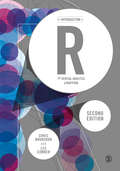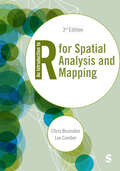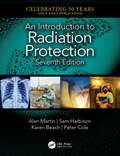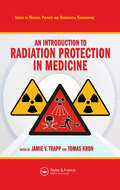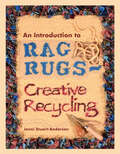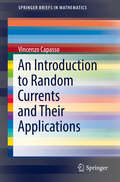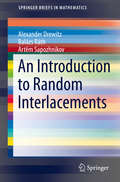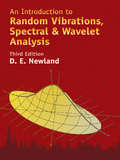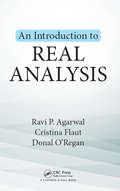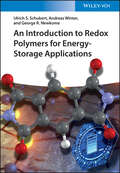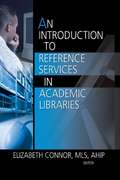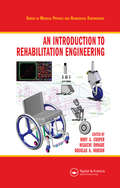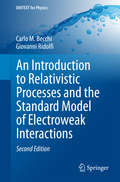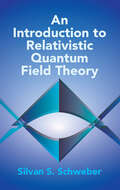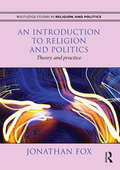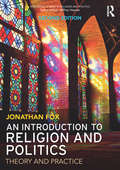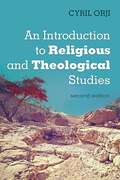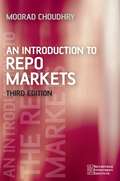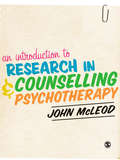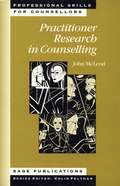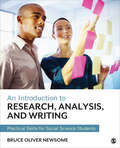- Table View
- List View
An Introduction to R for Spatial Analysis and Mapping (Spatial Analytics and GIS)
by Chris Brunsdon Lex ComberThis is a new edition of the accessible and student-friendly 'how to' for anyone using R for the first time, for use in spatial statistical analysis, geocomputation and digital mapping. The authors, once again, take readers from ‘zero to hero’, updating the now standard text to further enable practical R applications in GIS, spatial analyses, spatial statistics, web-scraping and more. Revised and updated, each chapter includes: example data and commands to explore hands-on; scripts and coding to exemplify specific functionality; self-contained exercises for students to work through; embedded code within the descriptive text. The new edition includes detailed discussion of new and emerging packages within R like sf, ggplot, tmap, making it the go to introduction for all researchers collecting and using data with location attached. This is the introduction to the use of R for spatial statistical analysis, geocomputation, and GIS for all researchers - regardless of discipline - collecting and using data with location attached.
An Introduction to R for Spatial Analysis and Mapping (Spatial Analytics and GIS)
by Chris Brunsdon Lex ComberThis is a new edition of the accessible and student-friendly 'how to' for anyone using R for the first time, for use in spatial statistical analysis, geocomputation and digital mapping. The authors, once again, take readers from ‘zero to hero’, updating the now standard text to further enable practical R applications in GIS, spatial analyses, spatial statistics, web-scraping and more. Revised and updated, each chapter includes: example data and commands to explore hands-on; scripts and coding to exemplify specific functionality; self-contained exercises for students to work through; embedded code within the descriptive text. The new edition includes detailed discussion of new and emerging packages within R like sf, ggplot, tmap, making it the go to introduction for all researchers collecting and using data with location attached. This is the introduction to the use of R for spatial statistical analysis, geocomputation, and GIS for all researchers - regardless of discipline - collecting and using data with location attached.
An Introduction to R for Spatial Analysis and Mapping (Spatial Analytics and GIS)
by Chris Brunsdon Lex ComberThe ever-expanding availability of spatial data continues to revolutionise research. This book is your go-to guide to getting the most out of handling, mapping and analysing location-based data. Without assuming prior knowledge of GIS, geocomputation or R, this book helps you understand spatial analysis and mapping and develop your programming skills, from learning about scripting and writing functions to point pattern analysis and spatial attribute analysis. The book: Illustrates approaches to analysis on a range of datasets that are new to this edition. Enables you to put your skills into practice with embedded exercises and over 30 self-test questions. Showcases the possibilities of using spatial analysis to explore spatial inequalities. Whether you’re an R novice or experienced user, this book equips upper undergraduates, postgraduates and researchers with the tools needed for spatial data handling and rich analysis.
An Introduction to R for Spatial Analysis and Mapping (Spatial Analytics and GIS)
by Chris Brunsdon Lex ComberThe ever-expanding availability of spatial data continues to revolutionise research. This book is your go-to guide to getting the most out of handling, mapping and analysing location-based data. Without assuming prior knowledge of GIS, geocomputation or R, this book helps you understand spatial analysis and mapping and develop your programming skills, from learning about scripting and writing functions to point pattern analysis and spatial attribute analysis. The book: Illustrates approaches to analysis on a range of datasets that are new to this edition. Enables you to put your skills into practice with embedded exercises and over 30 self-test questions. Showcases the possibilities of using spatial analysis to explore spatial inequalities. Whether you’re an R novice or experienced user, this book equips upper undergraduates, postgraduates and researchers with the tools needed for spatial data handling and rich analysis.
An Introduction to Radiation Protection
by Peter Cole Alan Martin Sam Harbison Karen BeachThis highly-readable account of the nature of the hazards presented by ionizing radiation and the methods of protection is an ideal introductory text for those new to the field, and for the non-specialist. The seventh edition continues to cover the technical principles underlying the control of radiation hazards, radiation detection and measurement and the biological effects of radiation, followed by a consideration of industry-specific radiation protection issues. Further specialised topics include risk assessment, waste management and decommissioning, radiological emergencies, relevant legislation and organizational issues and, new to this edition, environmental radiation protection.
An Introduction to Radiation Protection in Medicine (Series in Medical Physics and Biomedical Engineering)
by Jamie V. Trapp Tomas KronCombining facets of health physics with medicine, An Introduction to Radiation Protection in Medicine covers the background of the subject and the medical situations where radiation is the tool to diagnose or treat human disease. Encouraging newcomers to the field to properly and efficiently function in a versatile and evolving work setting,
An Introduction to Radio Astronomy
by Bernard F. Burke Francis Graham-Smith Peter N. WilkinsonRadio astronomy is an active and rapidly expanding field due to advances in computing techniques, with several important new instruments on the horizon. This text provides a thorough introduction to radio astronomy and its contribution to our understanding of the universe, bridging the gap between basic introductions and research-level treatments. It begins by covering the fundamentals physics of radio techniques, before moving on to single-dish telescopes and aperture synthesis arrays. Fully updated and extensively rewritten, the fourth edition places greater emphasis on techniques, with detailed discussion of interferometry in particular, and comprehensive coverage of digital techniques in the appendices. The science sections are fully revised, with new author Peter N. Wilkinson bringing added expertise to the sections on pulsars, quasars and active galaxies. Spanning the entirety of radio astronomy, this is an engaging introduction for students and researchers approaching radio astronomy for the first time.
An Introduction to Rag Rugs - Creative Recycling: Creative Recycling (Crafts Ser.)
by Jenni Stuart-AndersonMaking is good for you. Exploring crafts can be relaxing and therapeutic : the projects in this book are accessible to anyone who is inspired to recycle old clothes and textiles into unique, decorative, useful projects. Our forbears improvised tools to recycle their worn clothes - mostly dark suiting or mill waste if they lived near a mill. Usually they made mats for their cold floors or as draft excluders across doors. Nowadays you can choose from so many more colors and textures - painting with rags! Try one project or more. You will be able to use the techniques to design and make your own one-off items for your home or as hand-made gifts. The techniques here are traditional and simple - you will be surprised at how drab fabrics become transformed. Simple designs work best and you can even improvise as you work. If a fabric runs out, then use another - I call that organic design! Hooking is the best technique for pictorial detail and different techniques could be combined for original wall art. Historically, rugs were made by several people sitting round a horizontal frame with the children cutting the pieces of rag which were prodded into the hessian (burlap) backing to make a shaggy mat. There is a prodded project (for purists) but you can also achieve the same effect without a frame by progging, which can be done on table or thigh (carefully). Warning – this craft can be addictive!
An Introduction to Random Currents and Their Applications (SpringerBriefs in Mathematics)
by Vincenzo CapassoThis book introduces random currents by presenting underlying mathematical methods necessary for applications. The theory of currents is an advanced topic in geometric measure theory that extends distribution to linear functionals within the space of differential forms of any order. Methods to extend random distributions to random currents are introduced and analyzed in this book. Beginning with an overview of mathematical aspects of the theory of currents, this book moves on to examine applications in medicine, material science, and image analysis. Applied researchers will find the practical modern mathematical methods along with the detailed appendix useful to stimulate new applications and research.
An Introduction to Random Interlacements (SpringerBriefs in Mathematics)
by Alexander Drewitz Balázs Ráth Artëm SapozhnikovThis book gives a self-contained introduction to the theory of random interlacements. The intended reader of the book is a graduate student with a background in probability theory who wants to learn about the fundamental results and methods of this rapidly emerging field of research. The model was introduced by Sznitman in 2007 in order to describe the local picture left by the trace of a random walk on a large discrete torus when it runs up to times proportional to the volume of the torus. Random interlacements is a new percolation model on the d-dimensional lattice. The main results covered by the book include the full proof of the local convergence of random walk trace on the torus to random interlacements and the full proof of the percolation phase transition of the vacant set of random interlacements in all dimensions. The reader will become familiar with the techniques relevant to working with the underlying Poisson Process and the method of multi-scale renormalization, which helps in overcoming the challenges posed by the long-range correlations present in the model. The aim is to engage the reader in the world of random interlacements by means of detailed explanations, exercises and heuristics. Each chapter ends with short survey of related results with up-to date pointers to the literature.
An Introduction to Random Vibrations, Spectral & Wavelet Analysis: Third Edition (Dover Civil and Mechanical Engineering)
by D. E. NewlandOne of the first engineering books to cover wavelet analysis, this classic text describes and illustrates basic theory, with a detailed explanation of the workings of discrete wavelet transforms. Computer algorithms are explained and supported by examples and a set of problems, and an appendix lists ten computer programs for calculating and displaying wavelet transforms.Starting with an introduction to probability distributions and averages, the text examines joint probability distributions, ensemble averages, and correlation; Fourier analysis; spectral density and excitation response relations for linear systems; transmission of random vibration; statistics of narrow band processes; and accuracy of measurements. Discussions of digital spectral analysis cover discrete Fourier transforms as well as windows and smoothing. Additional topics include the fast Fourier transform; pseudo-random processes; multidimensional spectral analysis; response of continuous linear systems to stationary random excitation; and discrete wavelet analysis.Numerous diagrams and graphs clarify the text, and complicated mathematics are simplified whenever possible. This volume is suitable for upper-level undergraduates and graduate students in engineering and the applied sciences; it is also an important resource for professionals.
An Introduction to Real Analysis
by Ravi P. Agarwal Donal O'Regan Cristina FlautThis book provides a compact, but thorough, introduction to the subject of Real Analysis. It is intended for a senior undergraduate and for a beginning graduate one-semester course.
An Introduction to Redox Polymers for Energy-Storage Applications
by Andreas Winter Ulrich S. Schubert George R. NewkomeAn Introduction to Redox Polymers for Energy-Storage Applications Presents a well-founded introduction to the field or Redox Polymers, with didactical features like summary boxes and a Q&A sections An Introduction to Redox Polymers for Energy-Storage Applications discusses fundamental aspects related to polymer-based batteries, such as types of batteries, their historic development, design and synthesis criteria of the active material, and summarizes the various types of redox polymers and their applications. Each chapter contains learning objectives, summary boxes, and questions to allow for efficient exam preparation. In An Introduction to Redox Polymers for Energy-Storage Applications, readers will find detailed information on: Fundamental aspects of redox-active polymers, along with their historical classification, taking the key applications of the materials into account Energy-storage devices, containing polymers as the electrode active materials, and specific material requirements for the desired applications Classification of redox-active polymers, e.g., according to the nature of the actual redox-active moieties, their backbone structure, or topology Electrical conductivity of conjugated polymers, covering their most prominent representatives (polyaniline, polypyrrole, polythiophene, and polyacetylene) An Introduction to Redox Polymers for Energy-Storage Applications also covers the synthesis and applications of these materials, making it an excellent book for graduates, PhD students, and professionals who are starting in this field.
An Introduction to Reference Services in Academic Libraries
by Elizabeth ConnorAn introductory text on various aspects of reference services that requires your students to think!An Introduction to Reference Services in Academic Libraries is a comprehensive textbook that presents compelling case studies and thought-provoking essays that teach the principles of reference services. Eighteen authorities from private and public ac
An Introduction to Rehabilitation Engineering (ISSN)
by Hisaichi Ohnabe Douglas A. Hobson Rory A. CooperThis resource focuses on the principles, modeling, standards, devices, and technologies of rehabilitation engineering and assistive technology. It describes numerous design models and processes, including participatory action design and service delivery models. The book also discusses the components of devices such as cushions, wheelchairs, prostheses, orthoses, hearing aids, and TTYs. The contributors assess industry standards and explore innovative technology aids, such as sensors, robot-assisted therapy, and speech recognition software. The text contains a set of learning objectives and study questions in each chapter as well as a list of definitions at the end of the book.
An Introduction to Relativistic Processes and the Standard Model of Electroweak Interactions (UNITEXT for Physics)
by Carlo M. Becchi Giovanni RidolfiThis book offers a self-contained introduction to the theory of electroweak interactions based on the semi-classical approach to relativistic quantum field theory, with thorough discussion of key aspects of the field. The basic tools for the calculation of cross sections and decay rates in the context of relativistic quantum field theory are reviewed in a short, but complete and rigorous, presentation. Special attention is focused on relativistic scattering theory and on calculation of amplitude in the semi-classical approximation. The central part of the book is devoted to an illustration of the unified field theory of electromagnetic and weak interactions as a quantum field theory with spontaneously broken gauge invariance; particular emphasis is placed on experimental confirmations of the theory. The closing chapters address the most recent developments in electroweak phenomenology and provide an introduction to the theory and phenomenology of neutrino oscillations In this 2nd edition the discussion of relativistic scattering processes in the semi-classical approximation has been revised and as a result intermediate results are now explicitly proven. Furthermore, the recent discovery of the Higgs boson is now taken into account throughout the book. In particular, the Higgs decay channel into a pair of photons, which has played a crucial role in the discovery, is discussed. As in the first edition, the accent is still on the semi-classical approximation. However, in view of the necessity of a discussion of H !, the authors give several indications about corrections to the semiclassical approximation. Violation of unitarity is discussed in more detail, including the dispersion relations as a tool for computing loop corrections; the above-mentioned Higgs decay channel is illustrated by means of a full one-loop calculation; and finally, loop effects on the production of unstable particles (such as the Z0 boson) are now discussed. Finally, the neutrino mass and oscillation analysis is updated taking into account the major achievements of the last years.
An Introduction to Relativistic Quantum Field Theory
by Silvan S. Schweber"Complete, systematic, self-contained...the usefulness and scope of application of such a work is enormous...combines thorough knowledge with a high degree of didactic ability and a delightful style."--Mathematical ReviewsIn a relatively simple presentation that remains close to familiar concepts, this text for upper-level undergraduates and graduate students introduces the modern developments of quantum field theory. Starting with a review of the one-particle relativistic wave equations, it proceeds to a second-quantized description of a system of n particles, demonstrating the connection of this approach with the quantization of classical field theories. An examination of the restriction that symmetries impose on Lagrangians follows, along with a survey of their conservation laws. An analysis of simple models of field theories establishes the models’ content, and the problematic aspects of quantized field theories are explored.Succeeding chapters present the Feynman-Dyson perturbation treatment of relativistic field theories, including an account of renormalization theory, and the formulation of field theory in the Heisenberg picture is discussed at length. The book concludes with an account of the axiomatic formulation of field theory and an introduction to dispersion theoretic methods, in addition to a set of problems designed to acquaint readers with aspects of field theory not covered in the text.
An Introduction to Relativity
by Jayant V. NarlikarGeneral relativity is now an essential part of undergraduate and graduate courses in physics, astrophysics and applied mathematics. This simple, user-friendly introduction to relativity is ideal for a first course in the subject. Beginning with a comprehensive but simple review of special relativity, the book creates a framework from which to launch the ideas of general relativity. After describing the basic theory, it moves on to describe important applications to astrophysics, black hole physics, and cosmology. Several worked examples, and numerous figures and images, help students appreciate the underlying concepts. There are also 180 exercises which test and develop students' understanding of the subject. The textbook presents all the necessary information and discussion for an elementary approach to relativity. Password-protected solutions to the exercises are available to instructors at www. cambridge. org/9780521735612.
An Introduction to Religion and Politics: Theory and Practice
by Jonathan FoxAn Introduction to Religion and Politics offers a comprehensive overview of the many theories of religion and politics, and provides students with an accessible but in-depth account of the most significant debates, issues and methodologies. Fox examines the ways in which religion influences politics, analyses the current key issues and provides a state of the art account of religion and politics, highlighting the diversity in state religion policies around the world. Topics covered include: Secularism and secularization Religious identity Religious worldviews, beliefs, doctrines and theologies Religious legitimacy Religious institutions and mobilization Rational and functional religion Religious fundamentalism Conflict, violence and terror This work combines theoretical analysis with data on the religion policies of 177 governments, showing that while most of the world's government support religion and many restrict it; true neutrality on the issue of religion is extremely rare. Religion is becoming an inescapable issue in politics. This work will be essential reading for all students of religion and politics, and will also be of great interest to those studying related subjects such as comparative politics, international relations and war and conflict studies.
An Introduction to Religion and Politics: Theory and Practice (Routledge Studies in Religion and Politics)
by Jonathan FoxThis fully revised edition offers a comprehensive overview of the many theories of religion and politics and provides students with an accessible, in-depth guide to the subject’s most significant debates, issues, and methodologies. It begins by asking the basic questions of how social scientists see religion and why religion remains relevant to politics in the modern era. Fox examines the influence of religious identity, beliefs, institutions and legitimacy on politics, and surveys important approaches and issues found in the literature on religion and politics. Four new chapters on religious policy around the world, political secularism, and religious freedom and human rights have been added to fully revised content covering religious identity, rational choice approaches to religious politics worldviews, beliefs, doctrines, ideologies, institutions and political mobilization, fundamentalism, secularization, and religion and conflict. This work will be essential reading for all students of religion and politics, comparative politics, international relations, and security studies.
An Introduction to Religious and Theological Studies
by Cyril OrjiAn Introduction to Religious and Theological Studies walks students through topical issues to be encountered in the study of the Abrahamic religions: Judaism, Christianity, and Islam as these religions encounter other religions in the context of the wider ecumenism. The text is written from a Christian point of view and aims at helping students understand that to be Christian is to be ecumenical. African Traditional Religions (ATRs) has been included in this survey to provide background for the religious traditions and cultures of peoples of Africa as Christianity moves inexorably southward. The book has been written with undergraduate general education students in mind—including meeting the needs of those in seminaries and theological institutes.
An Introduction to Repo Markets
by Moorad ChoudhryThe Repo markets have grown dramatically in the past few years because of the need to hedge short positions in the capital and derivatives markets. Virtually all major currency markets in the world now have an established repo market, the facility is also increasingly being used in developing currency markets as well.This book is a practical introduction that focuses on the instruments, applications and risk management techniques essential for this rapidly evolving market. Fully updated to reflect the changes in these markets, the book also includes worked examples and case studies, and new sections on basket and structured finance repo.
An Introduction to Research in Counselling and Psychotherapy
by John McLeodIntroducing the basic principles of research theory and practice, this book is the ideal starter text for any counselling trainee or practitioner learning about the research process for the first time. Structured around common training topics, the book: - Explains why you need to do research at all: what it is, why it's important and its historical and philosophical context - Guides you through the confusing mass of research literature - Covers the ins and outs of actually doing research: practical and ethical issues - Helps you get the most out of research - how to evaluate the outcomes and use research to investigate the process of therapy. Written in a language familiar to first-year trainees and using a range of features to enhance learning, this accessible introduction will equip both trainees and qualified therapists with the essential nuts and bolts to understand research. John McLeod is Emeritus Professor of Counselling at the University of Abertay Dundee and adjunct Professor at the University of Oslo, Norway.
An Introduction to Research in Counselling and Psychotherapy (Professional Skills for Counsellors Series)
by John McleodIntroducing the basic principles of research theory and practice, this book is the ideal starter text for any counselling trainee or practitioner learning about the research process for the first time. Structured around common training topics, the book: - Explains why you need to do research at all: what it is, why it's important and its historical and philosophical context - Guides you through the confusing mass of research literature - Covers the ins and outs of actually doing research: practical and ethical issues - Helps you get the most out of research - how to evaluate the outcomes and use research to investigate the process of therapy. Written in a language familiar to first-year trainees and using a range of features to enhance learning, this accessible introduction will equip both trainees and qualified therapists with the essential nuts and bolts to understand research. John McLeod is Emeritus Professor of Counselling at the University of Abertay Dundee and adjunct Professor at the University of Oslo, Norway.
An Introduction to Research, Analysis, and Writing: Practical Skills for Social Science Students
by Bruce Oliver NewsomeThis accessible guide walks readers through the process of completing a social science research project. Written specifically to meet the needs of undergraduate research classes, it introduces students to a complete skill set, including: planning, design, analysis, argumentation, criticizing theories, building theories, modeling theories, choosing methods, gathering data, presenting evidence, and writing the final product. Students can use this text as a practical resource to navigate through each stage of the process, including choices between more advanced research techniques.
